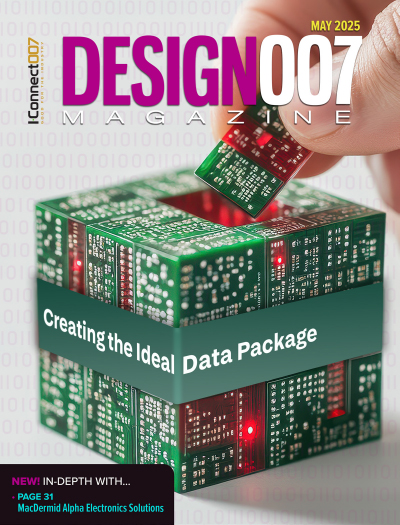-

- News
- Books
Featured Books
- design007 Magazine
Latest Issues
Current Issue
Showing Some Constraint
A strong design constraint strategy carefully balances a wide range of electrical and manufacturing trade-offs. This month, we explore the key requirements, common challenges, and best practices behind building an effective constraint strategy.

All About That Route
Most designers favor manual routing, but today's interactive autorouters may be changing designers' minds by allowing users more direct control. In this issue, our expert contributors discuss a variety of manual and autorouting strategies.

Creating the Ideal Data Package
Why is it so difficult to create the ideal data package? Many of these simple errors can be alleviated by paying attention to detail—and knowing what issues to look out for. So, this month, our experts weigh in on the best practices for creating the ideal design data package for your design.
- Articles
- Columns
- Links
- Media kit
||| MENU - design007 Magazine
Creating a Design Constraint Strategy
July 24, 2025 | I-Connect007 Editorial TeamEstimated reading time: 2 minutes
Feature Q&A With Kris Moyer, Global Electronics Association
Most designers learn how to set their design constraints through trial and error. EDA vendors’ guidelines explain how to use their particular tools’ constraints, and IPC standards offer a roadmap, but PCB designers usually develop their own unique styles for setting constraints.
Is there a set of best practices for setting constraints? That’s what I asked Global Electronics Association design instructor Kris Moyer, who covers design constraints in his classes. In this interview, Kris discusses how to identify PCB design requirements and set design constraints tightly enough for performance but flexible enough for manufacturing limitations.
What pre-layout analysis should be performed before you begin setting constraints?
Kris Moyer: There are several analyses that should be completed before setting constraints. These include the following:
- Timing/signal integrity: Used to set controlled impedance, termination, length matching and max length, and layer restrictions for digital signals.
- SPICE/power integrity analysis: Used to define the power distribution network (PDN) limits, the current requirements (trace widths), and voltage clearance requirements (Cu-Cu clearance).
- Thermal analysis: Used to determine how many plane layers, the copper weight of the plane layers, temperature rise of the traces (also used to define trace width), and any heat-sinking needed.
- Structural/mechanical analysis: This is the vibration, shock, and other environmental impacts to the design. It’s used to trade off between how many copper layers vs. board thickness for the stackup, and it is also used to evaluate the number and locations of mount holes or other support structures for the board. This analysis also leads to placement restrictions, such as specific placement of tall parts due to the design of the enclosure, or heavy/high mass parts due to special support structures designed into the housing, etc.
- Material analysis: This is an investigation of any special materials that may be needed, such as RF materials, flex materials, etc. These all have an impact on the stackup of the PCB and often lead to routing restrictions. For instance, you can only route the RF signals on the RF layers, or you have fewer routing layers available in the flex sections vs. the rigid sections of a rigid-flex board, limiting your ability to route signals from one rigid section to the next.
To continue reading this Q&A, which originally appeared in the July 2025 Design007 Magazine, click here.
Testimonial
"We’re proud to call I-Connect007 a trusted partner. Their innovative approach and industry insight made our podcast collaboration a success by connecting us with the right audience and delivering real results."
Julia McCaffrey - NCAB GroupSuggested Items
MacDermid Alpha Electronics Solutions Unveils Unified Global Website to Deepen Customer, Talent, and Stakeholder Engagement
07/31/2025 | MacDermid Alpha Electronics SolutionsMacDermid Alpha Electronics Solutions, the electronics business of Elements Solutions Inc, today launched macdermidalpha.com - a unified global website built to deepen digital engagement. The launch marks a significant milestone in the business’ ongoing commitment to delivering more meaningful, interactive, and impactful experiences for its customers, talent, and stakeholders worldwide.
Ansys 2025 R2 Enables Next-Level Productivity by Leveraging AI, Smart Automation, and Broader On-Demand Capabilities
07/30/2025 | PRNewswireAnsys, now part of Synopsys, announced 2025 R2, featuring new AI-powered capabilities across the portfolio that accelerate simulation and expand accessibility.
Connect the Dots: Sequential Lamination in HDI PCB Manufacturing
07/31/2025 | Matt Stevenson -- Column: Connect the DotsAs HDI technology becomes mainstream in high-speed and miniaturized electronics, understanding the PCB manufacturing process can help PCB design engineers create successful, cost-effective designs using advanced technologies. Designs that incorporate blind and buried vias, boards with space constraints, sensitive signal integrity requirements, or internal heat dissipation concerns are often candidates for HDI technology and usually require sequential lamination to satisfy the requirements.
Target Condition: The 5 Ws of PCB Design Constraints
07/29/2025 | Kelly Dack -- Column: Target ConditionHave you ever sat down to define PCB design constraints and found yourself staring at a settings window with more checkboxes than a tax form? You’re not alone. For many designers—especially those newer to the layout world—the task of setting up design constraints can feel like trying to write a novel in a language you just started learning.
Zuken to Showcase Defence & Security-Focused Electronic Systems Design Solutions at DSEI 2025
07/24/2025 | ZukenZuken, a global leader in electronic and electrical design automation, will showcase its latest innovations for defence and security systems at DSEI 2025, taking place at ExCeL London from 9–12 September 2025.


